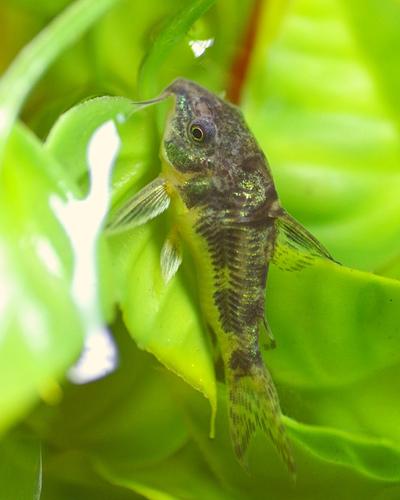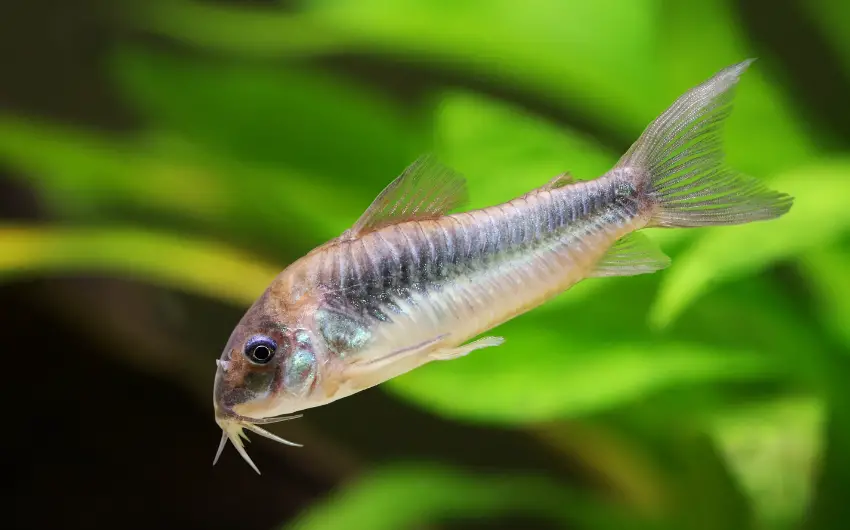Are you ready to delve into the world of Cory Catfish breeding? Do Cory catfish lay unfertilized eggs? This guide will help equip you with everything you need to ensure your breeding efforts succeed.
Cory catfish are beloved for their bright colors and friendly personalities, making them a popular addition to any home aquarium.
While many aquarists are familiar with the quirky traits of these lively fish, there is still much to learn regarding Cories’ reproductive habits.
One point that has sparked debate among hobbyists is whether or not Cory Catfish lie eggs – and if they do, are they unfertilized?
This blog post will cover critical topics such as whether Cory Cats lay unfertilized eggs and what challenges may arise during their reproductive cycle.

Plus, we have five crucial tips for successful Cory Catfish breeding that will significantly boost your chances!
Read on to discover the complexities of Cory reproduction and unlock the secrets to breeding these fascinating fish successfully.
Table of Contents
ToggleHow Often Do Cory Catfish Lay Eggs?
Cory Catfish can lay eggs several times throughout the year when conditions are ideal. In general, Cory’s breed between April and October, depending on the nature of their environment and water temperatures.

If you want your Corys to breed in captivity, aim for a steady water temperature range of around 75-80°F (24-27°C). It’s important to remember that Cory Catfish will usually only lay eggs if they are in pairs.
If you plan on spawning more than one pair of Cories, provide a separate tank for each couple.
Do Cory Catfish Lay Unfertilized Eggs?
Now, let’s address the fundamental question: do Corydoras Catfish lay unfertilized eggs? The answer is yes. Most of the time, Cory Catfish will produce unfertilized eggs if they are not in pairs or do not have access to a male mate.
Unfertilized Cory catfish eggs can be identified by their shape and size. They will typically be smaller, rounder, and darker in color than fertilized eggs.
5 Tips For Breeding Cory Catfish Successfully
Now that you know the basics of Cory Catfish breeding and understand more about whether they lay infertile eggs or not, let’s move on to some essential tips for successful breeding.
Provide the Right Environment
As previously mentioned, your Cory Cats will only lay eggs if their environment and water temperatures are suitable for reproduction. Ensure you maintain a consistent temperature in the breeding tank and provide plenty of hiding spots and plants for them to feel secure.
Feed High-Quality Food
Healthy food is a crucial part of Cory Catfish breeding. Ensure you provide your Cories with high-quality adult fish food that will help strengthen their immune system and boost their fertility.
Introduce Compatible Fish
Compatibility is vital when it comes to Cory Catfish breeding. Avoid introducing aggressive fish into the tank, as this can cause stress for your Corys and disrupt the egg-laying process.
Understand Gender Differences
Male and female Cory Catfish have different physical features that you should note when setting up pairs for spawning. Males typically have longer, more pointed fins than females.
Separate Pairs After Spawning
Once your Cories have spawned, separating the pair into two tanks is essential so the female can recover and replenish her energy.
By following these five tips for successful Cory Catfish breeding, you should be able to enjoy a successful spawning process with fewer issues along the way.
How Many Eggs Do Cory Catfish Lay?
On average, Cory Catfish can lay up to 50 eggs at a time. However, the exact number of eggs they lay will depend on the female fish’s age and size. Once your Cories have spawned, any infertile eggs should be removed from the tank to avoid contamination.
Viable eggs should also be removed and placed in a separate tank for hatching. The temperature of this tank should remain at around 75-80°F (24-27°C).
In short, Cory Catfish can lay fertilized and unfertilized eggs depending on the presence of male mates. It’s essential to provide a suitable environment and follow the tips mentioned above. To ensure successful breeding,
How to Know If Cory Catfish Eggs Are Fertilized?
Cory catfish eggs are small and complex to see unless they’re magnified. Look for a few key characteristics to determine if the eggs are fertilized.
The first thing to look for is discoloration. Fertilized Cory catfish eggs tend to be yellow-gray or brownish instead of white or transparent like most unfertilized Cory catfish eggs sacs.
In some cases, you may even spot a tiny black dot near the center of each egg, indicating that the male Cory Catfish’s spermatozoa have fertilized it.
It would help if you also examined each egg closely to determine its size and shape—the more significant and rounder an egg is, the more likely it is that it has been fertilized.
Additionally, try pushing your fingernail gently into one or two of the eggs; if they feel firm and do not collapse when pressed upon lightly, then this indicates that they are indeed fertile.
Finally, remember that once cory catfish eggs hatch (in 1-3 days, depending on water temperature), any remaining unhatched eggs will turn white as they become infertile over time due to lack of oxygenation from their environment or fungus growth caused by too much humidity around them!
How To Tell If Corydoras Catfish Is Male or Female?
Cory Catfish Male Vs. Female: Sexing corydoras catfish can be challenging, especially for inexperienced aquarists. One way to tell the difference between males and females is by looking at their dorsal fins.
Males typically have longer and more pointed dorsal fins than females, while female Cory Catfish tend to have shorter, rounder fins.
It would help if you also took note of the size of your Cories. Male Cory Catfish are usually larger than their female counterparts, so if you have two fish of the same age and size in your tank, you will likely have a pair of males.
Finally, watch for signs of spawning behavior, such as chasing or courting; males often try to entice female Cories by swimming around them and flaring their fins.
By observing these signs, you should be able to tell the difference between male and female Cory Catfish with greater accuracy.
What Do Cory Catfish Eggs Look Like?
Cory Catfish eggs are tiny and difficult to spot in a tank. They typically range in color from yellow-gray to brownish and have a transparent, jelly-like texture. The eggs should also be slightly larger than the size of a pinhead if they are fertilized and ready to hatch.
The eggs are usually found in clusters on the underside of rocks, plants, or other surfaces. They should be removed from the tank immediately to prevent water contamination and damage to developing larvae.
Signs That Tell Cory Catfish Is Pregnant
If you’ve noticed that your Cory Catfish has been unusually active and her stomach is swollen, then it’s likely that she is pregnant.
Other signs of a Cory Catfish’s pregnancy include frequent visits to the water’s surface and visible cory catfish egg sacks in her vent area. Additionally, she may begin searching for live foods more often and become more territorial with her tank mates.
If you suspect your Cory Catfish is pregnant, provide a suitable environment for the eggs to develop crucially. This includes ensuring proper water parameters (pH, temperature, etc.) are maintained and providing plenty of hiding places and cover for the female to
How Long Are Cory Catfish Pregnant?
Cory Catfish typically become pregnant after a week of courtship and mating, and the gestation period is usually between 7 and 14 days. During this time, the female will seek safe places to deposit her eggs and protect them from predators.
She will release her eggs into batches when ready to lay them in the water. The eggs then sink to the bottom of the tank, where they will hatch in 1-3 days depending on the temperature of the water.
Once hatched, removing any unhatched eggs from the tank as soon as possible is essential to prevent contamination and fungus growth. Feeding the baby fish with a high-protein diet is also vital to ensure they reach adulthood safely.
By providing the right environment and conditions, you can quickly identify if your Cory Catfish are pregnant and help them raise their fry successfully. With patience and proper care, you can look forward to seeing the next generation of Cory Catfish swimming in your aquarium!
Tips for Breeding Cory Catfish and Caring for the Eggs
Conditioning the Adult Fish
Before breeding your Cory Catfish, it is important to condition them by feeding them high-quality food and providing a suitable environment. This will help to ensure that your Cory Catfish are in good health and able to produce healthy offspring.
Providing Adequate Shelter
Providing plenty of shelter in your tank for the fish eggs is essential. This could be rocks, plants, or other structures protecting the eggs from predators.
Maintaining Water Quality
Water quality is essential for the health of cory eggs. Be sure to keep your tank clean and well-maintained to prevent contamination of the eggs.
Observe the Eggs for a Few Days
Observing the eggs for a few days after they are laid is crucial. This will help you identify any problems and take action as soon as possible.
Removing Unfertilized or Fungal-Infested Eggs
Removing any unfertilized or fungal-infested eggs from the tank as soon as possible is essential. This will prevent them from contaminating the water and infecting healthy eggs.
Place the Eggs in a Separate Container
Once the Corydoras eggs have been laid, placing them in a separate container is essential. This will help ensure that they are not disturbed while hatching and that the water parameters remain stable.
Provide Suitable Food for Fry
Once your Cory Catfish fry has hatched, providing them with suitable food is essential. This could include micro worms or newly hatched brine shrimp, which are both high in protein and essential for their growth and development.
Add a Few Hiding Places
As the fry grows, adding a few hiding places in the tank is essential. This will help them feel safe and secure from any potential predators.
Conclusion
Cory Catfish are an incredible species of fish to have in your aquarium. They are known for their curiosity, friendly behavior, and fascinating reproductive habits! A resounding yes is a final answer to whether Cory Catfish lay unfertilized eggs.
As demonstrated by detailed research, Cory Catfish reproduce with the fertilization of eggs that occur away from the mothers’ bodies, meaning that when carrying eggs, those eggs are, in fact, unfertilized. So aquarium owners who keep this fish species will be okay with having too many fish or dealing with aggressive mating behaviors in their tank. With this knowledge in mind, we hope that you feel empowered to care for your own Cory Catfish and share what you’ve learned with other curious hobbyists across the country!
You might also like
- How Often Do Cory Catfish Breeding? Beginners Kickstart (Guide)
- Do Cory Catfish Lay Eggs? Let’s Clear Up All the Confusion
- Cory Catfish Egg Development: Hatching Time & Care (Solved)
- What Do Cory Catfish Eggs Look Like? (5 Essential Care Tips)
- How Often Do Cory Catfish Lay Eggs – What You (Should Know)
- Do Cory Catfish Eat Their Eggs? (5 Essential Tips & Tricks)
- Male Vs Female Corydoras: 99.9% Accurate Sexing Guide
- Do Cory Catfish Breed Easily: (3 WARNING Signs of Trouble)





